Troubleshooting a bread. Rozwiązywanie problemów z chlebem [EN/PL]
Baking issues can happen to anyone, let's learn how to deal with them. Problemy z pieczeniem mogą przydarzyć się każdemu, nauczmy się z nimi walczyć.
English
We have a recipe for a wheat-rye bread (read it here). It’s bright, slightly dense, tastes great.
The recipe is quite simple: 100 g rye sourdough, 550 g white strong wheat flour, 12 g salt, 400 g water, 90 g seeds, poppy seeds on top. Mix it all, put it in a tin, wait till it rises, bake it.
At some point it became difficult to get our favourite flour. In result we decided to switch suppliers and that’s when problems the bread started.
The problems
Our first supplier, made strong flour with British grains only (if I remember correctly). It was just perfect for this recipe, but also quite good for other breads, like the ones with two-phase proofing and banetton rising - I just had to remove 10% water from the recipe.
With the second one we initially had similar results, but then we noticed the bread stopped rising and instead would crack open during baking as if the yeast just remembered they had work to do. Since I was reducing hydration at first, I decided to increase it now and it went well.
But then a batch of flour came with which we couldn’t bake using banettons. Reducing hydration wouldn’t help, the dough was runny and sticky all the time, the loaves would always come out flat. We solved it by adding a teaspoon of vital wheat gluten to flour when mixing.
We changed the supplier again and are currently sticking with not organic, but very local London miller. Boy, isn’t their flour strong! To give you an idea: with the first supplier it would normally take 3-5 hours for the bread to rise, depending on the temperature. With Wrights flour our sourdough can fail to get a 20% rise in 12-14 hours. Pop into the oven - it bursts open. It’s still tasty and stuff, but I do enjoy the flat top on this loaf. I like to call it a brick. I went with the initial solution - increase hydration - no effect. Can you imagine? 500 g water for 550 g flour is an insanely high hydration, it’s considered very high even for breads like ciabatta.
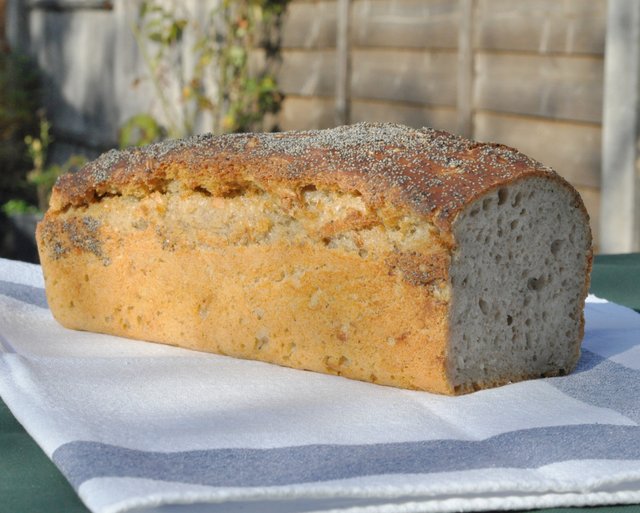
Could it be that this dough requires stretching and folding? I don’t know. It goes better when we add a bit of commercial yeast, so maybe the starter is too weak? Interestingly, the miller himself is also trying to bake using sourdough at the moment and struggles to get an open crumb.
I asked for any hints in a baking group I’m on, but that got me nowhere, sadly. I decided to make a test of weakening the dough.
What does strong mean for a flour?
There are numerous varieties of grains available and they have different properties. One of the key elements is protein content. Among them you will find glutein and gliadin which join their powers in touch with water to form gluten. That’s what matters here.
Depending on the gluten content the flour will present different behaviour: low gluten means the bake will be softer, will tear easily, will open much more when yeast start their work. High gluten means more springiness, but also a sough that stretches more without tearing. It also requires more strength from yeast to be able to lift it - kneading and then stretch and folds create multiple pockets of air that yeast then inflate.
Anyway, in my case the wild yeast wasn’t strong enough.
The experiment
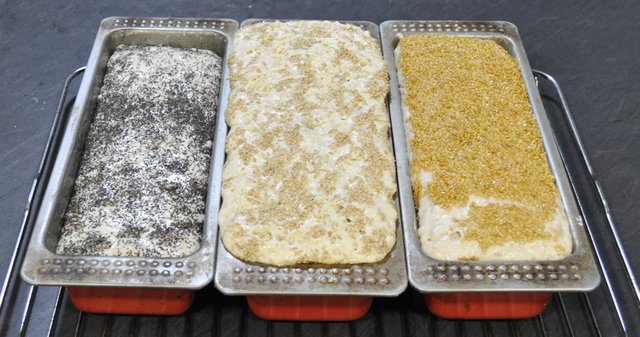
Here’s the modified recipe for this experiment:
- 450 g strong white wheat flour
- 100 g added flour
- 450 g water
- 100 g sourdough
- 12 g salt
- 90 g seeds
The added flour is:
- 100 g corn flour
- 100 g light rye flour
- 100 g strong white wheat flour (that is I used only one type of flour, for reference)
Preparation is as usual: mix it all together, let it rise overnight, bake.
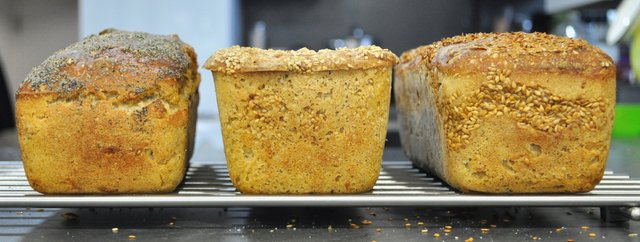
The outcome
The reference loaf acted as expected - it hardly had any rise and then burst in the oven.
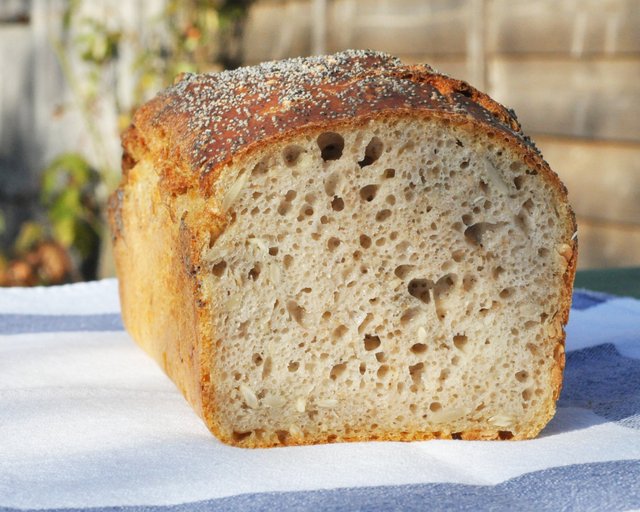
Corn flour - I was surprised with the outcome. Same temperature, same conditions, it flowed out of the tin and then collapsed a bit. It is a bit more yellow in colour, I haven’t noticed a significant difference in flavour. It feels that I should do more testing with less of it added.
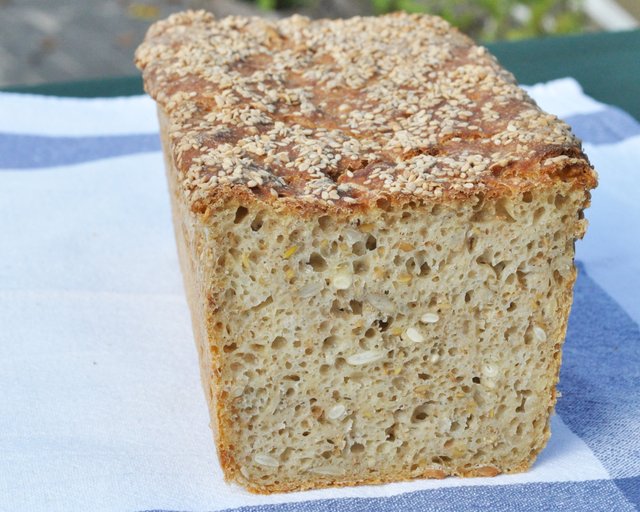
Rye flour - This bread rose just right. It had a nice dome on top and didn’t lose shape.
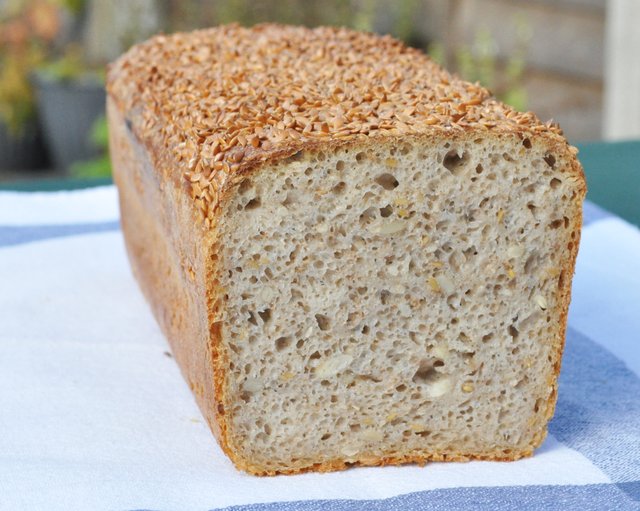
What led to such results?
This is a bit of guessing here, but my hypothesis has not been rejected by the experiment outcomes.
I think the flour is too strong for what I wanted to achieve. This is advantageous in some areas, so I need to learn how to handle this. That’s why I started adding other flours to test it.
Rye flour is different to what wheat provides - rye dough creates a clayish dough without a clear shape unless handled in a special way. Mixing it with wheat weakens the overall structure of dough. It also provides more enzymes like amylase that decompose starch into glucose and protease that damages gluten binds loosening the dough.
Both of them are present in wheat flour as well, but there is less of them and they are not so active. If you ever tried to bake a rye bread that would rise by itself without a tin, you would know what I’m talking about. The recipes that I know expect at most two hours rising of the final dough and very careful handling as the dough would collapse otherwise.
With that I’m not sure what to think of the corn flour. Could it be that the addition of starch without gluten would weaken the dough that much? It’s quite likely actually. Strong flour contains about 11.7% protein which gives 52.6 grams of protein in 450 grams of flour. Adding 100 grams of a glutenless flour like the corn one means there is now 9.6% protein in the dough. Also, the gluten present in there has to stretch more, is not that interconnected, so it’s easier for the wild yeast to inflate it. Nice one!
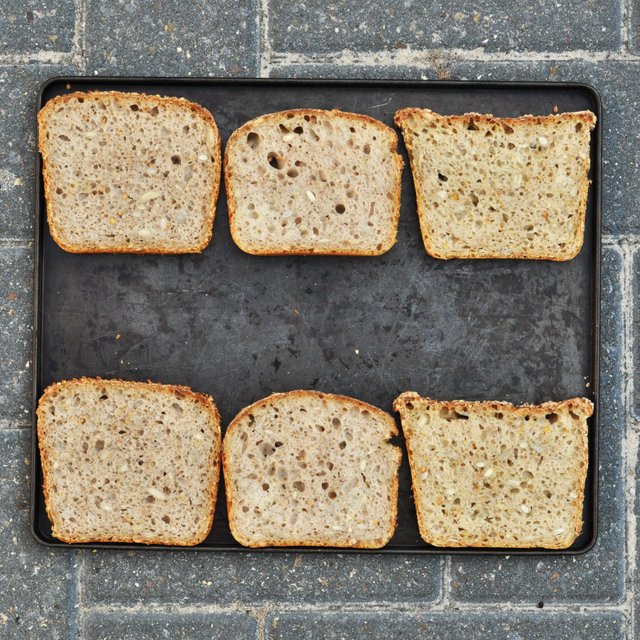
Now what?
I will continue with experiments. I will be adding smaller quantities of corn flour, maybe I will try with wholemeal and with potato flour. I want to find a reliable solution that would help me handle such problems.
How to investigate a baking problem?
Things will simply fail sooner or later. Things tend to not work out every now and then. You’re in luck if the problem is reproducible. You might need to contemplate a bit if it isn’t - my experience so far suggests an overlooked factor, even if it’s the baker him- or herself. Check out A baker needs to measure everything and ask yourself if you’re able to analyse the outcome of your baking. Maybe you missed the temperature? Changed flour source? New batch maybe?
Once you can get into a more or less reproducible state of the problem, write down your recipe and start changing one-two things at a time and observe, and note the results. Then plan the next iteration of testing, until you’re happy with the result.
This can be particularly problematic for new bakers, I know. It’s especially tricky to help them as having a bit of experience it’s just too easy to get into too much detail and this can have a discouraging effect. I’ve learned I need to learn to do it better.
If you want to start baking, if you would like to learn more about it, if you want to show off with your achievements (even if it’s a new simple thing), or if you want some help, feel free to post in #breadbakers. Include the recipe, include the pictures and let’s have fun together.
Polish
Mamy przepis na chleb pszenno-żytni (zapoznaj się tu). Jest jasny, lekko gęsty, smakuje świetnie.
Jest on dość prosty 100g zakwasu żytniego, 550 g mąki chlebowej, 12 g soli, 400 g wody, 90 g ziaren, posypać makiem. Wymieszać, dać w foremkę, zostawić do wyrośnięcia, upiec.
W pewnym momencie pojawił się problem z zakupem naszej ulubionej mąki, a po zmianie dostawcy pojawił się też problem z samym chlebem.
Problem
Pierwszy dostawca robił mąkę chlebową wyłącznie z ziaren brytyjskich (o ile dobrze pamiętam). Do tego przepisu była doskonała, w innych chlebach też dawała radę, w tych z dwufazowym wyrastaniem i z użyciem kosza - musiałem tylko usunąć 10% wody z przepisów.
Drugi dostawca początkowo dostarczał mąkę, która dawała podobne rezultaty, ale w pewnym momencie zauważyliśmy, że chleb przestał rosnąć i dopiero pękał w piekarniku jak gdyby drożdże działały z opóźnieniem. Pierwszy pomysł, jaki przyszedł mi do głowy żeby temu zaradzić, to zwiększyć hydrację (bo przecież wcześniej musiałem obniżać) - przyniosło to zamierzony efekt.
Jednak kolejna partia mąki nie nadawała się do pieczenia w koszach. Nawet ponowne obniżenie nawodnienia nie pomogło - ciasto było lejące i klejące, bochenki rozlewały się na płasko. Gdy dodaliśmy odrobinę glutenu w proszku, problem znikał.
Ponownie zmieniliśmy dostawcę i obecnie postawiliśmy na mąkę nie ekologiczną, ale za to bardzo lokalną, od młynarza z Londynu. O Mamo! To jest mocna mąka! Tak aby dać wyobrażenie: na mące od pierwszego dostawcy chleb mógł podwoić objętość w 3-5 godzin, zależnie od temperatury. Na mące od Wrights po 12-14 godzinach może wciąż nie być 20% rozrostu. Wkładam go do piekarnika - gwałtownie rośnie i rozrywa się. Wciąż jest smaczny i w ogóle, ale jednak lubię jak chleb wyrośnie z płaskim wierzchem. Mówię na niego "cegła". Spróbowałem pierwotnego rozwiązania - zwiększenie hydracji - ale bez efektu. Wyobraź sobie: 500 g wody na 550 g mąki to bardzo wysoka hydracja, nawet ciabatty rzadko mają tak wysoką.

Czy może być, że ciasto wymaga rozciągania i składania? Nie wiem. Jeśli dodamy odrobinę drożdży piekarskich, wynik jest lepszy, więc może zaczyn jest za słaby? Co ciekawe, młynarz sam próbuje zrobić chleb na zakwasie ze swojej mąki i też miewa problemy z uzyskaniem otwartego miękiszu.
Poprosiłem o rady na jednej z grup piekarskich, do których należę, ale nie otrzymałem pomocy. Postanowiłem potestować osłabianie mąki.
Co czyni mąkę mocną lub chlebową?
Jest wiele odmian ziaren, mają one też różne właściwości. Jednym z kluczowych elementów jest zawartość białek. Wśród nich występują gluteina i gliadyna, które łączą swoje moce w kontakcie z wodą, tworząc gluten. To on ma tu znaczenie.
Zależnie od zawartości glutenu mąka będzie wykazywać inne właściwości: niska zawartość oznacza że ciasto będzie delikatniejsze, będzie się łatwiej rwać, a dodatek drożdży do ciasta da bardziej otwarty miękisz. Wysoka zawartość glutenu oznacza większą sprężystość, ale też ciasto, które potrafi bardziej się rozciągnąć bez podarcia. Wymaga też koniecznie większej mocy w drożdżach, aby ciasto urosło. Wyrabianie, a potem rozciąganie i składanie tworzą wiele kieszonek z gazem, które potem są dmuchane przez drożdże.
Podejrzewam, że w moim przypadku dzikie drożdże nie miały dość siły.
Eksperyment

Tak oto zmodyfikowałem przepis:
- 450 g mąki chlebowej pszennej
- 100 g dodanej mąki
- 450 g wody
- 100 g zakwasu
- 12 g soli
- 90 g ziaren
Dodana mąka to:
- 100 g mąki kukurydzianej
- 100 g jasnej mąki żytniej
- 100 g mąki chlebowej pszennej (czyli użyłem jednego rodzaju mąki, jako punkt odniesienia)
Przygotowanie jak zwykle: wymieszać, dać wyrosnąć, upiec.
Rezultat

Bochenek referencyjny wyszedł zgodnie z przewidywaniami - ledwo się podniósł, a potem go rozsadziło w piekarniku.

Kukurydziana mąka - zaskoczył mnie wynik. Ta sama temperatura, te same warunki. Ciasto wyszło z foremki, a potem trochę opadło. W kolorze chleb jest nieco bardziej żółty, w smaku nie odczułem jakiejś konkretnej różnicy. Wydaje mi się, że mogłem zastąpić mniejszą ilość mąki.

Mąka żytnia - chleb wyszedł idealnie. Dobrze wyrósł przed pieczeniem i nie rozlał się.

Co spowodowało takie wyniki?
Trochę tu zgaduję, ale moja hipoteza nie została odrzucona w eksperymencie.
Myślę że kupiona mąka jest zbyt mocna do tego, co chcę osiągnąć. Daje korzyści w niektórych zastosowaniach, więc muszę się nauczyć z nią pracować. Dodatek mąki słabszej wydaje się być dobrym rozwiązaniem i dlatego zacząłem próbować.
Mąka żytnia daje inny efekt niż pszenna - ciasto żytnie przypomina bardziej glinę, bez wyraźnej struktury, chyba że zostanie odpowiednio przygotowane. Dodanie jej do mąki pszennej osłabia strukturę ciasta, daje też więcej enzymów takich jak amylaza, która rozbija skrobię na glukozę, oraz proteaza, która niszczy nieco gluten, rozluźniając ciasto.
Oba te enzymy są dostępne i w mące pszennej, ale jest ich mniej i nie są aż tak aktywne. Jeśli kiedykolwiek spróbujesz upiec chleb żytni, aby wyrósł sam, bez foremki, będziesz wiedzieć, o czym mówię. Znane mi przepisy żytnie przewidują nie więcej niż dwie godziny wyrastania końcowego i bardzo delikatne obchodzenie się z ciastem, inaczej łatwo opadnie.
Nie wiem co myśleć o mące kukurydzianej. Czy mogło być tak, że dodanie skrobi bez glutenu aż tak osłabia strukturę ciasta? W gruncie rzeczy jest to możliwe. Mąka zawiera 11,7% białka co w 450 gramach mąki daje 52,7 grama białka. Dodanie 100 g mąki bezglutenowej, takiej jak kukurydziana, oznacza że białka jest teraz 9,7%. Poza tym teraz gluten musi się mocniej rozciągnąć, nie jest aż tak połączony, więc dzikim drożdżom łatwiej go napompować. Nieźle!

Co teraz?
Będę kontynuował z eksperymentami. Będę dodawał mniejsze ilości mąki kukurydzianej, może też spróbuję z mąką pełnoziarnistą i ziemniaczaną. Chcę znaleźć kilka rozwiązań, na których mogę polegać, aby radzić sobie z takim rodzajem problemów w przyszłości.
Jak przeanalizować problem z pieczeniem?
Prędzej czy później coś nie wyjdzie. To normalne. Masz szczęście jeśli problem jest powtarzalny. Musisz trochę pomyśleć jeśli nie jest - z mojego doświadczenia wynika, że zazwyczaj przyczyną jest jakiś pominięty czynnik, w skrajnym przypadku tym czynnikiem jest sam piekarz. Zapoznaj się z Piekarz wszystko musi mierzyć i zadaj sobie pytanie, czy jesteś w stanie przeanalizować swój wypiek. Może to wina temperatury? Inny dostawca mąki? Może inna jej seria?
Kiedy już osiągniesz powtarzalność problemu, zanotuj przepis i zacznij zmieniać po jednej rzeczy na raz i obserwować rezultat. Zanotuj wyniki, po czym zaplanuj kolejne podejście próbne i tak w kółko, aż osiągniesz satysfakcjonujący rezultat.
To może sprawiać trudności szczególnie nowym piekarzom. Trudno jest im pomagać, ponieważ z doświadczeniem łatwo zacząć podawać zbyt wiele szczegółowych informacji, a to może stać się bardzo zniechęcacjące. Póki co nauczyłem się, że muszę nauczyć się pomagać.
Jeśli chcesz zacząć przygodę z pieczeniem, jeśli chcesz się więcej o tym nauczyć, jeśli chcesz się pochwalić swoimi rezultatami (nawet tymi najprostszymi) lub jeśli potrzebujesz trochę pomocy, śmiało pisz w #breadbakers. Uwzględnij przepis ze zdjęciami i pobawmy się razem.
This is very interesting. I haven't tried using a sourdough starter yet, but I am enjoying experimenting. I made a rye loaf last week (50% rye flour, 50% strong white flour). It looked very pretty, but didn't rise very much. I will try it in a tin next time. Interesting about the hydration, I haven't tried changing the proportions of water and flour. I read your post about measuring everything but I must admit I am quite slapdash about it 😎.
The bread was beautiful!
It didn't rise most likely due to two reasons : 65% hydration and 50% content of a wholemeal rye flour which isn't easy to raise. I've read in a book once that there should be some sourdough involved if they're is more than 30% rye flour, but I'm not sure how true this is as the book itself was rather poor quality. But still, adding a bit of prefermented rye dough in place of some rye flour could give some change, for instance Detmold method uses 80% or so sourdough in the final dough.
Oh, and the measuring doesn't matter that much most of the time, so don't worry :)